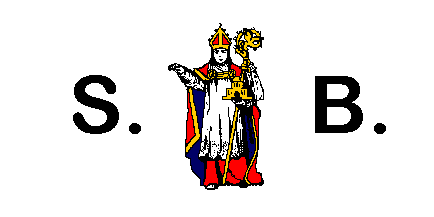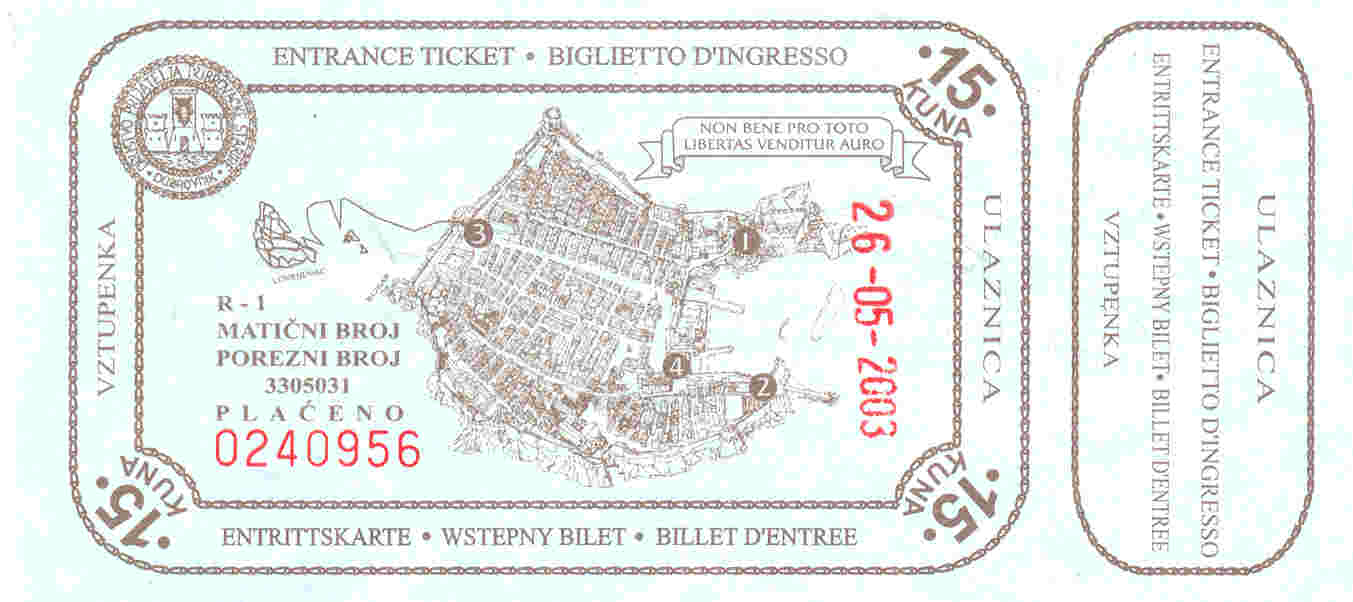 |
Dubrovnik |
I have divided my description Dubrovnik into three sections. Since the tour description is so long, I have provided it on its own page.
But first, some pictures of Dubrovnik ...
|
|
|
| Sunset over the Old Harbor | The dome of Saint Blaise's Cathedral |
|
|
|
| Looking north from a vista near the airport | Testing out the zoom function on the camera |
The History of
Dubrovnik
Like Split, its sister city further up the
the Dalmatian coast, Dubrovnik was founded by refugees displaced by the Avar-Slavic
invasions in the 7th c. CE. The Roman city of Epidaurum,
located under the site of present-day Cavtat, was attacked by the Slavic conquerors.
The city's residents fled to Laus, which was a small islet separated by a narrow
channel. Laus is Greek for "rock", which morphed into
Rausa, Ragusa and Ragusium. From the 7th c. CE to the 12th
c. CE, Ragusa was under the protection of Byzantium, which helped the town build
walls and fortifications to protect against invasions.
The Slavs settled on the other side of the channel, named their town Dubrovnik after dubrava, the holm-oak tree that was plentiful in the countryside. By the 12th c. CE, the narrow channel had filled with silt and the town settled merged into one town. The silted channel was paved and became the Placa, which is now the main east-west thoroughfare in the old town.
In 1204, the Venetian won control of Dalmatia, including Dubrovnik; this shift in control was a product of the Crusades. The republic provided protection from the Slavic invaders, thus allowing Dubrovnik merchants to concentrate on developing trade relations with its inland neighbors. Through the Peace Treaty of Zadar in 1358, the Venetians were replaced by the Hungarians, under the King Louis. Hungarian rule was a unique arrangement for Dubrovnik: the Dalmatian city paid an annual tribute for protection, but it remained a city-state with its own elected government. This government, which ruled the Respublica Ragusina, was led by the knez, who was elected for a one-month period. Unique to the position, he could only leave the palace for official state visits.
For the next several hundred years, Dubrovnik grew to an important power in the Mediterranean shipping and trade industries. It controlled colonies from the Peljeac peninsula and Mljet Island in the north to Cavtat in the south. Through its fleet of almost 200 vessels (third largest on the Mediterranean), it connected Mediterranean trade with the Balkan hinterland, routes on which Dubrovnik had a virtual monopoly. The city dealt in commodities like wheat, wool, hides and slaves. In spite of this power, though, the city-state maintained excellent relations with all players, including the formidable Ottoman Empire.
The wealth generated by the mercantile industries provided many services for the city's residents, including:
- 1301 - medical services
- 1317 - pharmacy
- 1347 - retirement home
- 1377 - first quarantine hospital, known as the lazaret
- 1432 - orphanage
- 1436 - waterworks
The city's golden age existed between the 15th and 16th c. CE. Its artistic communities produced great works of architecture, art and literature. Many of the writers, such as Drić and Gundulić, wrote in Croatian instead of their native tongue. This popularity provided a needed boost to the vernacular, and the Dubrovnik dialect, known as to, became the official version of Croatian. In 1525, the republic began to pay tribute to the Ottoman empire for protection; the practice continued until Dubrovnik was dissolved in 1808 by the French. The agreement with the Turks also allowed Dubrovnik merchants to trade within the entire empire, for only a 2% customs tax.
By the 17th c. CE, Dubrovnik's luster began to wane. In 1667, an earthquake killed around 5000 residents and destroyed much of the town. Hindering the rebuilding efforts were the constant looting raids by bands of Bosnians from the interior. This practice would continue until 1783, when the Bosnian pasha, who orchestrated these actions, was killed in the Siege of Vienna. The city began to rebuild its infrastructure, this time in the Baroque style. The ensuing war between Austria and Turkish, however, would immolate Dubrovnik's interior trade monopoly and, consequently, most of the city's wealth.
In 1815, the Congress of Vienna awarded Dubrovnik to the Austrians. But the city was a shell of its former self. The trade routes were gone, and the fleet had been confiscated by the British navy. Many emigrated from the city and, by 1853, 80% of the homes stood unoccupied. With the arrived of the Austrians, power shifted to Spilt and Zadar; a move from which Dubrovnik never recovered.
After World War I, the city became to develop as a tourist center. It lured foreign tourists with its temperate climate, Adriatic beaches and historical treasures. The city was inscribed in the UNESCO list of World Heritage Sites in ??
This industry suffered immensely during the recent war of independence. According to one account, approximately 70% of all buildings in the old town were hit by mortar fire. Many buildings were razed, while the protective wall suffered over one hundred direct hits. The damage was estimated at US$10 million. But the city has rebuilt and now welcomes tourists ...
Tour of the
Dubrovnik's Landmarks
There are a number of sites to see in Dubrovnik. Since inclusion of this
information would make this page large, I have separated it into its own
page. Click here to connect to
that page.
The walk around the protective walls, known locally as the Gradske zidine, is the best way to become acquainted with the city. I did this tour in the middle of the afternoon heat, not something I would recommend. Touring in the morning allows the visitor to take advantage of the cooler temperatures and orient himself to the city's geography. I have included some pictures of my "wall tour" below
 |
|
| Entrance ticket to the Dubrovnik city walls tower; a great bargain at HRK 15 | |
|
|
|
| This is looking north toward the Minceta Tower. Notice the people in the bottom left corner; this is the pathway on which the visitor walks. | Looking southwest from the northern section of the wall. In the distance is the Fort Lovrijenac, which protected the city from hostile invaders. |
|
|
|
| Looking due south from the northern walls. In the upper center portion of the picture is the Collegium Ragusinum, the old Latin school that was run by the Jesuits. | Looking south-southeast. Nearly 70% of these tiles were damaged or destroyed during the recent war of independence. They were replaced with similar tiles from France. |
|
|
|
| Looking southeast in the direction of Lokrum Island. In the foreground is Saint Blaise's Cathedral and the Sponza Palace. | Looking east, with Lokrum Island on the right. There is a large cruise shipped docked just outside the old harbor. |
|
|
|
| From the Minceta Tower, this is the view looking southeast toward Lokrum Island. | Again, from Minceta Tower, this is the view looking south. Notice on the upper right side are the protective walls. |
Restaurants
and Cafés
Dubrovnik has a number of quality restaurants, which an ample selection
specializing in seafood. The hosts and hostesses are very aggressive in
seeking your business. Never commit to a restaurant until reviewing the
menu, which is usually posted outside the restaurant or near the group of café
tables. If possible, sit outside; this will provide an exciting
people-watching experience.
The first night I sampled fruits de mer at a restaurant off the square near the main cathedral. Located at Nilole Tesle 2, the restaurant was named Cicrina. I had a small garden salad, followed the Dubrovačkli Uitak, which is a sampling of three types of seafood entrées. These tasty dishes were complemented by a glass of Croatian white wine. I was the only person in the restaurant for a long time, but it was still early. Many people passed the outdoor café, but few stopped to look at the menu. By the time I departed, there were a few tables occupied.
I had an after dinner hot tea at a café right on Placa, Utd Ragusa. It is one of the many congregation points on Placa, so there was plenty of commotion. I enjoyed my tea while watching the droves of locals and tourists enjoy their evening walks.
Most of the old town's restaurants are located on Prijeko, which is located one block north of Placa. The street, which is a pedestrian zone, is filled with outdoor restaurants, specializing in many different cuisines. For lunch on my second day, I ate at Konoba Kapetan. I must admit that I picked the restaurant for its attractive host, at whom I stared for most of the lunch period. When I wasn't gawking, I ate my salad and Becki, the Croatian version of Salisbury steak.
Travel
Resources
For those planning a trip to Dubrovnik, there are several resources on the
Internet about this southern Dalmatian city.
- Dubrovnik Tourist Bureau
- Croatian Tourist Bureau information on Dubrovnik
- Meteorological information from the Weather Channel
Return to the Main
Croatia Page